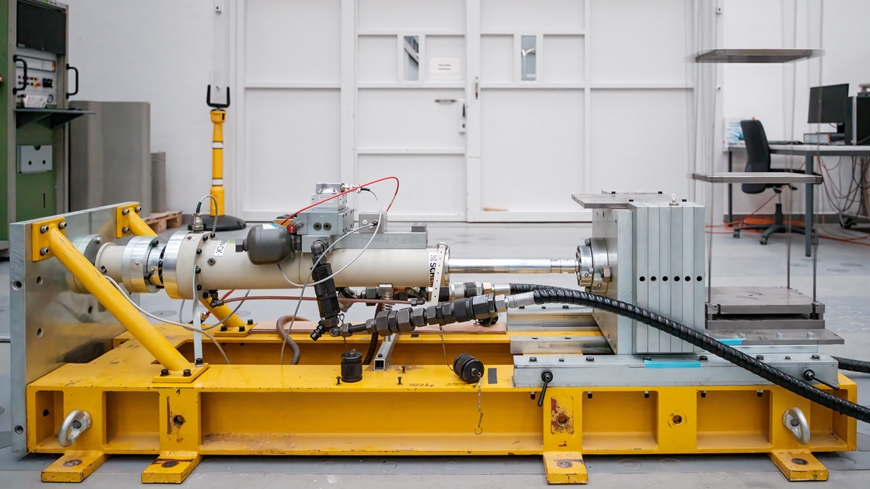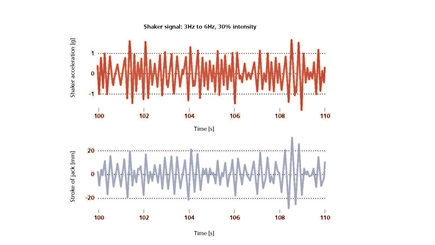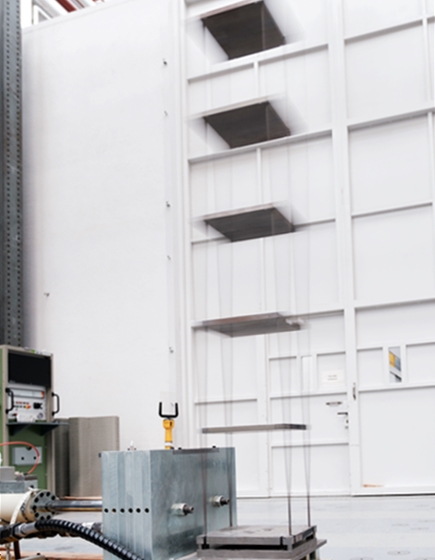A shaker for construction research
Shaken, not stirred
Multi-storey timber buildings are extremely popular. To prevent them from being damaged by strong winds or earthquakes, sufficient bracing must be provided in the supporting structure. Computer calculations provide the basis for this. To check these in practice and improve the computer models, Empa researchers use a two-ton “shaker”.

In Empa's largest laboratory in Dübendorf, the Bauhalle, an impressive experiment will be set up for the Open Day on September 14, 2024. The centerpiece is the so-called “shaker”. Instead of using it to mix cocktails for visitors, Empa's civil engineers René Steiger, Pedro Palma, and Robert Widmann from the “Structural Engineering” research lab will use the shaker to demonstrate how a model of a building vibrates, as can occur during earthquakes. The researchers use the model to show how the weight and stiffness distribution in the structure influence the way it vibrates.
The background to this demonstration: timber buildings are becoming increasingly popular in Switzerland, also because of the sustainability potential of timber as a renewable building material. Timber buildings up to 75 meters in height and more than 20 storeys are now being built in Switzerland, but the majority of timber buildings are 4 to 5-storey timber-frame buildings. In order to ensure the structural rigidity of buildings made with prefabricated timber frame elements and nailed wood-based panels, and to prevent damage caused by strong wind gusts or earthquakes, structural engineers can follow different strategies: they can either provide additional load-bearing walls or increase the load-bearing resistance of the existing walls by using thicker components, stronger materials or more fasteners. The bottom line is that this means more material and more work, which results in higher costs. Added to this, stiffening is not the best solution in every case. In order to absorb earthquake shocks, it is sometimes even more advantageous if the structure is not too rigid, but can react deform to a certain degree. This must also be taken into account in the computer calculations.
Realistic data supports architects and planners

The entire timber construction industry, as well as architects, engineers and building owners, are therefore interested in realistic data on stiffness, natural frequencies, and damping in multi-storey timber buildings in order to find the best solution for their project. This is the only way to ensure that exactly the right amount of material is used - and in the right places.
For a long time, there were only mathematical approximations, but no real data collected on typical multi-storey timber buildings. Although shake table tests on timber buildings were carried out in Japan and North America, the results are not easily transferable to the Swiss conditions, as they simulate strong earthquakes. In addition, the Japanese and North American construction methods and buildings differ significantly from those in Switzerland. This is, in part, due to different requirements for thermal insulation, sound insulation, and fire protection. Also missing is information on the rigidity of entire wall elements or walls that extend over several storeys, since in building standards engineers only find values for the properties of individual nailed, stapled or screwed connections, timber-frame parts and planking materials.
The “shaker” that makes a house swing

This is where Empa's “Shaker” comes into play, the hydraulic horizontal oscillator that can set up to 1000 kg of oscillating masses in motion in a controlled manner. It had an important application for research into timber frame construction a few years ago when it was hoisted by crane to the top floor of a wooden apartment building under construction in Oberglatt in the canton of Zurich. The 1000 kg mass was then set in motion, thanks to the precise control of the servo-hydraulic cylinder, causing the wooden house to sway horizontally. Just as would be expected from gusts of wind or minor earthquakes in the Zurich lowlands. Meanwhile, acceleration sensors measured the horizontal movements of the building on three storeys and provided values of structural rigidity, natural frequency and damping. The measurements were taken during three different construction phases.
This allowed the researchers to observe directly how the building became increasingly rigid: in the first phase only the load-bearing walls acted as bracing, in the second phase the non-load-bearing planking of the walls was also installed, and in the third phase the windows were installed. “The first results already showed that the calculations on the model did not match the experiments,” says Steiger. The supporting structure proved to be significantly stiffer than had been calculated based on the specifications in the standards and the models used.
Such experimental measurements, as well as the projects in the Empa laboratory, provide information on how the used building materials affect the stiffness, natural frequency and damping of buildings. With their work, the scientists help to supplement standards and computer models, and they support civil engineers and architects in optimizing their planning. They are also strengthening the competitiveness of timber as a sustainable building material for multi-storey buildings.
Dr. René Steiger
Ingenieur-Strukturen
Phone +41 58 765 4215
Open Lab Day
On September 14, 2024, Empa Dübendorf will open the doors of its laboratories to the public. At over 70 stations, visitors will be able to experience current Empa research live on topics such as climate change, the energy transition, human and environmental health and much more. The stories in this issue give a small taste of the variety of materials and technologies that are discovered, researched, and developed in Empa's laboratories. Hungry for more? Visit us on September 14!
Read the latest EmpaQuarterly online or download the PDF version.
-
Share







